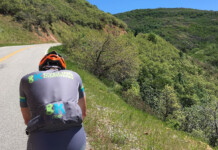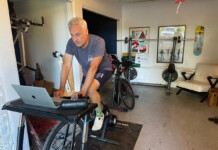If you’ve been training with a heart rate (HR) monitor or power measuring device that logs your workouts for later analysis, you may be surprised how much you’re NOT pedaling during each ride. The use of HR monitors and the growing popularity of power meters mean constant and precise tracking of the work you’re doing or aren’t doing in the saddle at all times.
Coaches and mentors working with an athlete for the first time may initially serve as a broken record emphasizing key tenets of structured training:
– stick to your own prescribed workout or training regimen, not a groups or someone elses
– unless you’re one of the riders setting the pace, be conscious of the work you’re not doing
There is no doubt that focusing on more continuous effort during a ride can be beneficial. Some coaches get fanatical about it, insisting that their riders pedal at all times, including on downhill sections. Naturally, this could prove dangerous, especially on a technical descent or in adverse weather conditions. Still, there is no reason not to continue pedaling on a descent, when drinking from water bottles or when adjusting your speed given pack or traffic dynamics, as long as you do so SAFELY.
When you’re coasting, you’re not working. Longtime coach and founder of Whole Athlete, Dario Fredrick, explains that unless you’re producing force and therefore doing work, you’re not training or reaping a benefit. If you’re not putting power to the pedals, you aren’t getting the training stimulus from your workout that is intended to effect a physiological benefit, or adaptation. Essentially, you’re resting or recovering, which only serves a purpose if intentional.
Coasting has its place, such as when a rider needs to rest in order to continue a workout, or when recovering from a high exertion interval e.g. hill repeat, sprint, targeted training zone defined by range of HR or power, etc. However, more often than not, a coach builds in lower intensity zones for rest and recovery as opposed to coasting phases.
Stopping can represent an even bigger no-no, especially if its longer than customary stops for traffic lights, water refills or bio breaks. A good rule of thumb is to keep moving, keeping the pedals turning.
Fredrick emphasizes that every structured workout has a purpose. First and foremost, from a coach’s perspective, were looking at what a rider is seeking to accomplish within the framework of a specific training session: What is the intention of the workout and what is the riders focus? Then we have the rider target so many hours at a certain intensity or at intervals of varying intensities. Intensity equals stimulus, with each stimulus eliciting a certain adaptation in the body.
The subject of group and even race rides vs. individual rides becomes particularly salient at this point. Group rides, even those that seem especially fast or hard can represent surprisingly little total work for an individual athlete, explains Fredrick. Typically they consist of short, hard efforts followed by a lot of coasting and drafting. One common fallacy is that if you’re tired following a ride, you’ve had a good workout. When in fact, it could be that going out for two hours at a lower yet sustained intensity may result in a greater benefit. You’re talking very different types of stimuli.
Group rides can vary as far as how useful they are its all about training impulse. Its important to be aware that if you’re not dictating the pace, you are at the mercy of what others are doing. Benefits of group riding are:
– confidence riding in a group, especially a diverse group
– opportunity to push yourself harder during short efforts because you have others pushing you; in particular instances, such efforts can even serve as race or event simulation
– its often largely social, so enjoyment and motivation levels can be higher
In the end, it depends on the format and nature of the group ride. If it can be effectively implemented into a riders overall training plan and goals, many coaches have no problem supporting such participation.
Its important to be aware that different groups and riding companions have their own unwritten rules regarding waiting for others who suffer mechanicals i.e. technical issues or flat tires. One way to deal with these types of stops is to have a designated helper wait and assist the hampered rider. That way, others can continue at a slow pace and be caught later, or can continue at a faster pace with the intention of turning around at some point to come back for those temporarily left behind. There will always be those who cry etiquette foul in those instances, but a little flexibility on everyone’s part makes for higher quality workouts for all.
This makes choice of training venue, whether riding in a group or alone, extremely important. Picking a well suited route will facilitate a workout, while an ill suited route can undermine it.
Which leads us to the final consideration: the effectiveness of trainer workouts. Sure, they can be boring and most cyclists would rather ride outside than anchored to a stationary device. But Fredrick insists that it often trumps outdoor riding for effectiveness as well as efficiency, and that being creative helps: You need to be sensitive to the need to keep indoor workouts interesting, and specificity is key. HR monitors and power meters make a huge difference.
Some riders think that interesting means intense, continues Fredrick, but Ive coached riders who did 95% of training indoors, and we kept it diverse by hitting the entire exertion range. That also goes for athletes with little time at their disposal; limited time doesn’t mean that workouts are primarily high intensity. You will certainly need a large, powerful fan to help minimize cardiac drift, where heart rate becomes exaggerated relative to workload. Since you wont have air passing over you, your natural cooling mechanism wont be working as effectively as when you’re training outside.
Different coaches consider rests and stops differently, but most would insist that you’re looking to accomplish a certain amount of work during a ride. Fredrick clarifies that when he tells a rider to spend 2 hours within one or more training zones during an outdoor ride, it may imply a 3 hour outing depending on the venue.
Ultimately, the way to achieve training targets most efficiently is through consistent output: More continuous effort equals more consistent stimulus, often increasing the benefit from that stimulus, concludes Fredrick.
follow Mark Deterline on Google Plus







